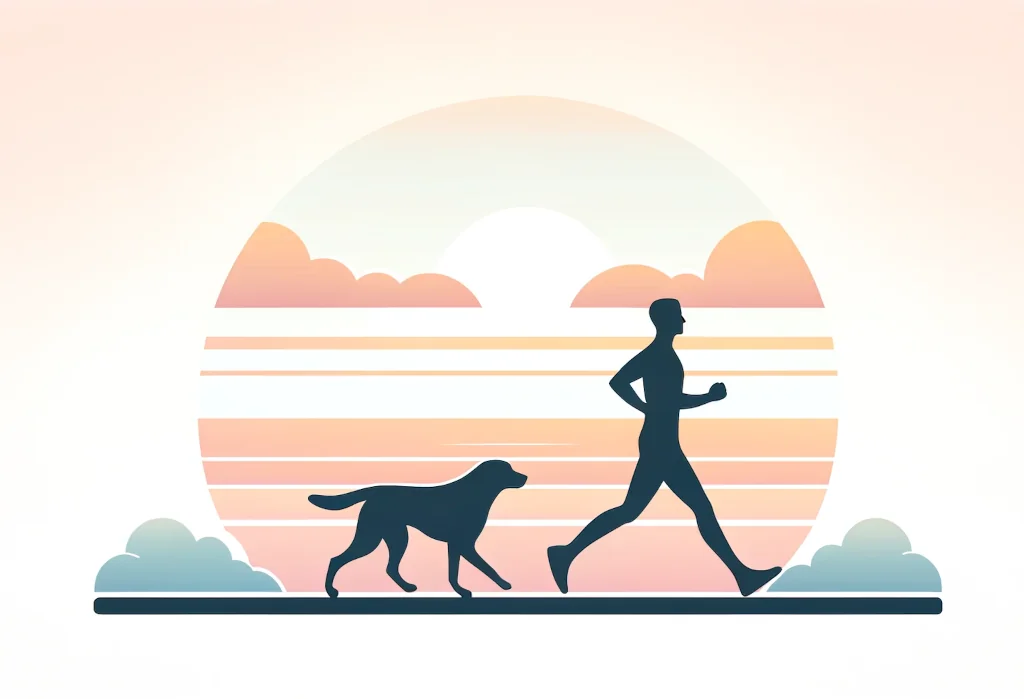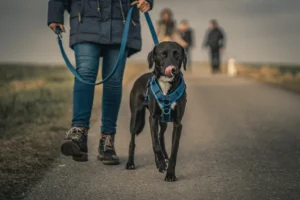You know that joyful slobber and the wagging tail that greets you every time you lace up your sneakers for a run? Yes, your four-legged friend is game for anything that gets those paws moving. But while both your hearts are set on the same goal—staying fit together—the path to get there isn’t just a walk in the park.
This read promises to be your trusty leash, guiding you through the dos and don’ts of breaking a sweat with your furriest workout buddy.
Key takeaways:
- Schedule a vet consultation to tailor an exercise regime that suits your dog’s breed, age, and health.
- Start with short walks, gradually increase to jogs with hydration breaks, watching for signs of fatigue or discomfort.
- Invest in reflective gear, a comfortable dog harness, and protective booties if needed for safety.
Is My Dog Fit for Exercise?
Before you hit the road or the park with your furry best friend, it’s wise to do a quick health check.
Not all dogs are built for a 5K run right off the couch—figuring out your dog’s current fitness level is crucial to avoid injuries or undue stress. Some breeds, for instance, may be prone to joint issues (here’s looking at you, Labrador Retrievers), while others like Greyhounds are built like canine athletes but may not have the stamina for long-distance exercises.
It’s not just breed-specific considerations to think about; age and current health play a huge part too. Puppies and senior dogs will have different tolerance levels. Always, and I can’t stress this enough, consult with your veterinarian before starting any exercise program. A pre-exercise checkup can help pinpoint potential risks and tailor a workout regime that fits your dog’s unique needs.
Key Takeaway : Your canine pal needs a green light from the vet to ensure they’re ready to jog, not just wag.
How Can We Start Slow and Build Up?
Rome wasn’t built in a day, and neither is your dog’s fitness. Starting slow gives both you and your dog a chance to adapt to the new routine without overwhelming your bodies. Low-impact exercises are your best friend here. Think leisurely walks and gentle games of fetch to get the ball rolling.
Let’s break it down: begin with a 15-minute walk a few times a week and observe how your dog handles it. Do they seem winded or are they still bouncing with energy? Adjust the time and pace accordingly. After a week or two, if your dog is handling it like a champ, bump it up—add five minutes to your walks or introduce a mild jog for short distances.
Remember to watch your dog for any signs of fatigue or discomfort, and take it down a notch if they’re struggling. It’s a marathon, not a sprint, after all.
Exercise Sample Starter :
– Week 1-2: 15-minute walks, 3-4 times a week
– Week 3-4: Increase to 20-minute walks, introduce short jogging intervals
– Week 5+: Gradually extend duration and intensity, add playful activities like fetch or agility drills
Pro Tip : Mix it up! Dogs, like us, can get bored with the same old routine.
What Safety Gear Do We Need?
Safety isn’t just a buzzword; it’s essential when working out with your pup. Here’s the skinny on the safety gear you need to consider:
For your dog:
- A sturdy harness that fits comfortably, offering better control and less strain on your dog’s neck compared to a collar.
- Reflective gear or an LED collar for those early morning or evening jaunts to increase visibility.
- Booties if you’re traversing rough terrain or in extreme temperatures (hot pavement or snow), safeguarding those precious paws.
For you:
- Quality running shoes to save your feet and back from excess strain.
- Reflective clothing or accessories to ensure you’re visible to others, particularly if you’re jogging roadside.
A hydration pack or belt keeps water on hand for you and your dog, because staying hydrated is key, especially on those longer adventures.
Don’t Forget : A portable water bowl and waste bags for those pit stops.
And here’s something that might not cross your mind: pet insurance. Accidents happen, and when they do, pet insurance can be a financial lifesaver for unexpected vet visits due to injuries.
Gear up, start slow, and always keep your dog’s well-being at the forefront. With these tips, you and your furry friend are all set for a safe and enjoyable workout journey!
Quick Tip : Keep an eye out for upcoming posts where we’ll deep dive into other aspects of keeping fit with your furry companion!
How Do I Keep My Dog Hydrated and Cool?
When you’re out getting some good old exercise with your furry buddy, staying hydrated and cool is crucial. Dogs don’t sweat like we do – they cool off through panting and can easily get overheated, so here’s the inside scoop on keeping your pup’s tail wagging, not dragging.
First things first, always bring more water than you think you’ll need for both you and your pooch. Some nifty tools to help include collapsible bowls or doggy water bottles with built-in troughs. If you’re going for a long hike or run, consider a doggy hydration pack—they’re not just adorable but practical too.
Now, we all love basking in that golden glow, but exercise during the cooler parts of the day—dawn and dusk—are best to avoid the heat. And keep an eye on the ground temperature; asphalt can get hot enough to fry an egg, let alone burn sensitive doggy paws. Here’s a pro tip: place the back of your hand on the pavement, and if it’s too hot to keep there for at least 5 seconds, it’s a no-go for Fido.
Watch out for these clear signs of heat exhaustion in dogs: – Excessive panting or difficulty breathing – Increased heart and respiratory rate – Drooling, weakness, or stupor – Mildly elevated body temperature (over 104°F is a warning)
If you spot any of these signs, get your dog to a cooler place, provide water, and it wouldn’t hurt to call a vet just to be on the safe side. Prevention is always better than treatment, after all.
What Are the Best Exercises We Can Do Together?
Here we get to the fun part! Whether you’re a fitness rookie or a marathon runner, there’s no shortage of activities to get your heart rates up together.
Running is the old faithful. Whether it’s casual jogs or more structured running, ensure that your dog is suited to long-distance jaunts before hitting the pavement for a marathon prep. Breeds like Labradors and border collies might run circles around you, but if you’ve got a brachycephalic (read: short-nosed) pooch like a pug, you’ll want to take it much easier.
Hiking offers adventure and new sniffs for your dog, and a solid workout for you. Just make sure to tackle trails that match your pal’s fitness level and paw toughness. Bring plenty of water and keep an eye out for wildlife that might not appreciate a frolicsome canine.
For something that really ticks the box for ‘unique’, how about canine freestyle? This is dancing with your dog, folks. It’s a full-on bonding experience that gives mental and physical stimulation for both of you. Plus, it’s a serious workout (try doing spins and leg weaves for several minutes and say otherwise). It’s not a common activity, and it’s sure to turn heads in the park.
Now, if you’re looking to spice it up a notch, agility courses are a fantastic way to get moving. You can join a club or build your own makeshift course in the backyard. Weaves, jumps, and tunnels aren’t just a test of your dog’s nimbleness—they’ll have you huffing and puffing too!
Always adjust your activities to the age, breed, and overall health of your dog. Start slow, and remember that consistency is key. Play it by ear and change your routine if your buddy seems bored or unengaged. Their waggy tail—or lack thereof—will give you the feedback you need.
Remember; mix it up, keep it fun, and exercise will be a treat for both of you. So lace up, clip that leash on, and get ready for a panting good time with your four-legged exercise partner!
Alex, a passionate animal lover, has experience in training and understanding animal behavior. As a proud pet parent to two dogs and three cats, he founded AnimalReport.net to share insights from animal experts and expand his knowledge of the animal kingdom.










